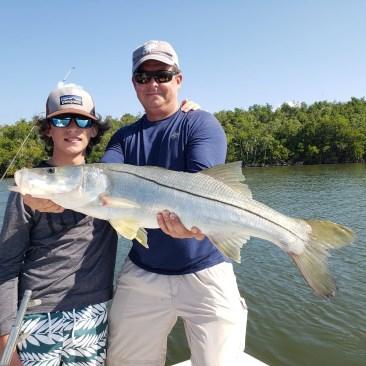
5 minute read
Event Calendar p. 3 Local News/ Capt. Merritt
Living Gulf Coast by Charles Sobczak River Otter (Lutra canadensis) Other names: common otter / Status: FL=stable but extirpated in 11 states and endangered in 13 more, IUCN=LC / Life span: to 20 years / Length (including tail): 26-42 in. (66106 cm) / Weight: 11-30 lb (5-14 kg) / Reproduces: near water in suitable dens; will often use another animal’s burrow or find natural holes in riprap and tree roots / Found: diurnal in all six counties.
There are 12 species of otters worldwide. The mammal appears on every continent except Australia and Antarctica. The largest of the freshwater species is the giant otter of the Amazonian basin, weighing up to 66 pounds; the shorter but heavier sea otter of the north Pacific coastline can weigh up to 90 pounds. Throughout its range, otter populations are declining as a result of continued habitat loss and the harvesting of its meat and fur.
Advertisement
The only aquatic member of the weasel family, the otter is renowned for its playfulness. Curious and entertaining to observe, it is a favorite at zoos and aquariums. Children seem to gravitate to the otter naturally, as they do with the dolphin. In the wild, the otter is far less playful but is still known to slide down a muddy embankment repeatedly or engage in other behavior that can only be described as having fun. Aside from primates, the sea otter is the only mammal known to use tools when harvesting food.
The diet of the river otter is largely made up of fish, both fresh and saltwater species. It prefers slower-moving fish such as gar, panfish, and catfish, but will catch just about any fish it can. It also eats crawfish, horseshoe crabs, frogs, coots, ducks, beetles, and on rare occasions, muskrats and marsh rabbits.

An otter is capable of holding its breath for up to four minutes, diving as deep as 60 feet and swimming as fast as six-miles per hour. Its fur is so dense that its skin never gets wet. Young otters, even though they are born with webbed feet and will eventually spend most of their lives in the water, must be taught how to swim by their parents. The otter is very vulnerable to water quality issues and will quickly abandon any polluted lakes or streams. Poor water quality has been a major factor in the otter’s decline worldwide. The river otter is slowly being reintroduced into states where it once was plentiful, including Iowa, Kansas, Kentucky, Nebraska, New Mexico, North and South Dakota, Ohio, Oklahoma, Tennessee, and West Virginia. It was formerly found in all of these states, but over the past few centuries has been trapped for its high-quality fur, causing localized extinctions. Most states now protect the otter.
The otter is preyed upon by alligators, bobcats, coyotes, and wolves. Because of its unusual method of running, arching its back high into the air as it runs, it is very vulnerable to automobile collisions. Oil spills are especially troublesome for the otter. The Exxon Valdez spill in Prince William Sound killed more than 1,000 sea otters and dozens of river otters within days. By and large the otter is a rare sighting. It is most often spotted in the early mornings and at dusk. Sadly most of the otters we see are those who have been killed in automobile collisions. The best locations to find river otters are in areas with multiple freshwater ponds, where you can sometimes see them crossing over from one body of water to another. In Florida, where otters are Open 8 am to 3 pm Daily protected, the species is making a strong comeback. Many coastal otters were severely impacted by the 2004 and 2005 hurricane seasons and populations along the coast are currently lower than normal.
Charles Sobczak is a photographer and writer from Sanibel Island. Photo: An Otter Family at Play by Heather Green Fishing the 10,000 Islands
With Captain Mike Merritt
It seems the weather is becoming more stable, at least as far as the winds go. It has been windy but not as bad. The Snook fishing has picked up a little. Today, I had clients catch around 20 Snook with 4 being slot size fish. We also saw a school of around 100 Snook cruising a mangrove shore. There were all sizes mixed in. Hopefully the bite continues to get hot!

The afternoon rains have finally started so get out early and be prepared to run back in early if you want to stay dry. So far, there’s not too much lightning but this will also change - so be cautious.
Work the shallow shorelines on the incoming tide with top water or jigs to catch these fish. Just remember to get them back in the water as quick as possible. Also if there are sharks around take the time to maneuver those big ones back to some cover away from these predators.
Summer for me is all about the Snook! There should be fish all around and there is nothing better than the fight of a big Snook. Those long runs are hard to beat. Then you add those jumps and head shakes and it's worth all the effort you made in getting that hook up. I landed my first one at 8 yrs. old and 51 years later I am still excited to hook up! Only now it is just as satisfying to see my clients on a good fish.
We have been catching some in the 35" to 38" range lately and hope to see a few 40" plus again this summer. Last year our biggest was 45". So far this year it is a 43". If you put in the time you can catch these fish!
Now, not to leave out the Tarpon, Reds, Seatrout, Snapper, Tripletail and all the others, as they will all be caught this month. Even the Black Drum are still around. Enjoy the bite this month and good luck fishing!




